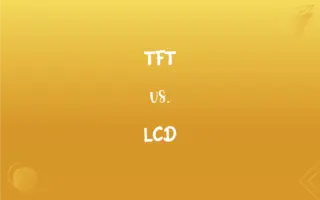Period vs. Group: What's the Difference?
Edited by Aimie Carlson || By Janet White || Published on February 12, 2024
In the context of the periodic table, a period refers to a horizontal row of elements, while a group refers to a vertical column, each categorizing elements with shared properties.

Key Differences
In the periodic table, a period represents a horizontal row. Elements in the same period have the same number of atomic orbitals. Each period indicates the highest energy level an electron in that element occupies in its ground state. A group, however, is a vertical column in the periodic table. Elements within the same group share similar chemical properties due to having the same number of electrons in their outermost shell.
The length of each period varies because it reflects the number of elements that can occupy the available sublevels. There are seven periods in the periodic table. In contrast, groups are consistent in the periodic table, with 18 groups in total, including both the main group elements and the transition metals.
Elements in the same period are not as chemically similar as those in the same group. This is because their valence electrons are in different shells. In groups, elements tend to exhibit similar chemical and physical properties, as they have similar valence electron configurations.
The concept of periodicity, which refers to the recurring trends in the properties of elements across each period, is fundamental in chemistry. Group trends are also crucial, as elements in a group often react similarly or have related physical properties.
Periods in the periodic table illustrate the progressive filling of electron shells, which influences an element's reactivity and properties. In groups, the elements typically have a similar state of matter at room temperature, similar reaction behaviors, and trends in physical properties like melting and boiling points.
ADVERTISEMENT
Comparison Chart
Orientation
Horizontal row in the periodic table
Vertical column in the periodic table
Element Properties
Same number of atomic orbitals
Similar chemical properties
Length/Consistency
Varies in length
Consistent, with 18 groups
Chemical Similarity
Less chemically similar
More chemically similar
Trends
Illustrates filling of electron shells
Exhibits similar reactivity and state
ADVERTISEMENT
Period and Group Definitions
Period
A set of elements with the same number of atomic orbitals.
All elements in the second period have electrons in two shells.
Group
Indicates consistent trends in properties.
Elements in a group often have similar melting points.
Period
A division based on electron shells.
Moving across a period, elements progressively fill up their outer electron shells.
Group
A vertical column in the periodic table.
Group 1 contains the alkali metals.
Period
A horizontal row in the periodic table.
Oxygen and fluorine are in the same period.
Group
Elements with similar chemical properties.
Elements in a group typically react in similar ways.
Period
Reflects the highest energy level of electrons in the ground state.
Elements in the third period have electrons in the third shell.
Group
Characterized by the same number of valence electrons.
All elements in Group 17 have seven valence electrons.
Period
Indicates progressive filling of electron shells.
The periodic table's periods help us understand electron configuration.
Group
Shares similar reactivity and state of matter.
Group 18 elements are all noble gases and share similar non-reactive properties.
Period
An interval of time characterized by the occurrence of a certain condition, event, or phenomenon
A period of economic prosperity.
Group
An assemblage of persons or objects gathered or located together; an aggregation
A group of dinner guests.
A group of buildings near the road.
FAQs
What does a period indicate about an element?
It indicates the highest energy level an electron occupies in its ground state.
Are periods consistent in length?
No, the length of periods varies.
Do elements in the same group have similar reactivity?
Yes, they typically share similar chemical behaviors.
Do elements in the same period have similar properties?
They have similar energy levels, but not necessarily similar properties.
How many groups are there in the periodic table?
There are 18 groups.
How many periods are in the periodic table?
There are seven periods.
Do elements in the same period have the same number of electrons?
They have electrons in the same shell, but not the same number.
What is a period in the periodic table?
A horizontal row of elements with the same number of atomic orbitals.
What do groups tell us about elements?
They indicate similar valence electron configurations and chemical properties.
Are all elements in a group in the same state of matter?
Often they are, but not always.
What's an example of a group trend?
Alkali metals becoming more reactive down the group.
Why are periods different lengths?
Due to the progressive filling of electron subshells.
Which period are alkali metals in?
Alkali metals are in various periods, but all in Group 1.
Can elements in the same group be in different states?
Yes, depending on the group.
Are noble gases a period or a group?
They are a group, Group 18.
What is the significance of group and period trends?
They help predict chemical behavior and properties of elements.
What is a group in the periodic table?
A vertical column of elements with similar chemical properties.
Do elements in the same group have the same atomic number?
No, atomic numbers increase down a group.
How does electron configuration change across a period?
Electrons fill higher energy levels as you move across a period.
What distinguishes one period from another?
The progressive filling of electron shells.
About Author
Written by
Janet WhiteJanet White has been an esteemed writer and blogger for Difference Wiki. Holding a Master's degree in Science and Medical Journalism from the prestigious Boston University, she has consistently demonstrated her expertise and passion for her field. When she's not immersed in her work, Janet relishes her time exercising, delving into a good book, and cherishing moments with friends and family.
Edited by
Aimie CarlsonAimie Carlson, holding a master's degree in English literature, is a fervent English language enthusiast. She lends her writing talents to Difference Wiki, a prominent website that specializes in comparisons, offering readers insightful analyses that both captivate and inform.







































































